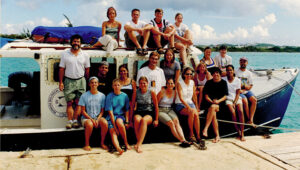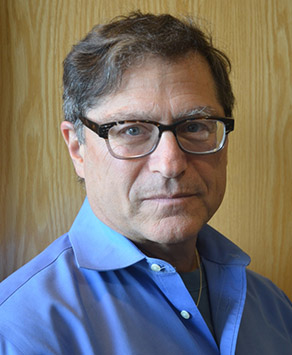Catching up With a Colleague

Dr. Fred Lipschulz (left, shown in 1995 during a Coral Reef Ecology course) was a faculty member of BIOS for 14 years beginning in 1989. A biological oceanographer from Harvard University, he began as a research scientist studying the nitrogen cycle in the open ocean; symbiotic relationships in corals and sea anemones; and phytoplankton metabolism. By 2000, he was serving as the head of academic affairs in addition to his role as a research scientist, and the following year he was promoted to senior scientist. During a recent visit to BIOS, Lipschultz spoke about his experiences as an early career scientist at the Institute, as well as his career since he left in 2003.
In 1989, BIOS was still known as the Bermuda Biological Station for Research and its logo was an angelfish surrounded by a concentric ring of nautical rope. Back then, the Institute’s research vessel was Weatherbird II, acquired that year to support the increased use associated with the open-ocean research and equipment testing for which BIOS became known. And when biologist and educator Dr. Edward F. MacNichol, Jr. made a generous gift in memory of his parents, the MacNichol Fund was established, allowing the Institute to recruit talented young scientists to establish their own independent research programs. The first hire was Fred Lipschultz, then a postdoctoral student and biological oceanographer from Harvard University, who arrived in September 1989.
Lipschultz quickly settled in, securing funding for his research from a variety of sources including the National Science Foundation (NSF) and the Office of Naval Research. His first studies focused on the nitrogen cycle in the open ocean; mutually beneficial relationships, or symbiosis, in corals and sea anemones; and using flow cytometry (a technology that uses lasers to analyze single cells in a solution) to study phytoplankton metabolism.
By 2000, he was serving as head of academic affairs in addition to his role as a research scientist. In this capacity, he developed two semester-long programs for undergraduate students that allowed BIOS to function as a year-round educational institution for the first time since its founding in 1903. The following year, his contributions to BIOS’s research and education programs were recognized when he was promoted to senior scientist. Although Lipschultz physically left BIOS at the end of 2003 to start a new career within the U.S. federal government as an NSF Program Officer in Chemical Oceanography, he remained a BIOS employee for nearly 25 years as part of a federal “rotator” program, designed to foster improved connections between academia and government service.
Last fall, Lipschultz returned to Bermuda with his wife, Diana Lynn, and visited BIOS to catch up with friends and former colleagues. During their visit they also participated in the annual virtual poster session with fall interns and their mentors, where they listened to interns present their research projects in a setting designed to mimic poster sessions at professional scientific conferences.
During his BIOS visit, Lipschultz spoke about his experiences as an early career scientist at the Institute, as well as his career since he left in 2003.

Although Lipschultz physically left BIOS at the end of 2003 to start a new career in the U.S. federal government as an NSF Program Officer in Chemical Oceanography, he remained a BIOS employee for nearly 25 years as part of a federal “rotator” program, designed to foster improved connections between academia and government service. Today, Lipschultz is the Senior Scientist at the United States Global Change Research Program (USGCRP), which is a federal program mandated by Congress since 1990 to coordinate federal research and investments in global climate change research.
How did you hear about the job opportunity at BIOS?
Jim Butler, who was the president of the BIOS Board of Trustees at the time, was also a professor at Harvard. He told me that Tony Knap, the then-director of BIOS, was looking to hire and was coming to Harvard for a visit. My thinking at the time was that if a door opens, you take a leap, so I applied and moved to the island with my wife and our two children, Eli (age 7) and Erica (age 5).
What was it like when you first arrived?
The new labs in the Naess Building hadn’t been built yet and the warehouse wasn’t there. The new ship [Weatherbird II] hadn’t even arrived yet; it was actually en route from Woods Hole Oceanographic Institution in Massachusetts and most of our stuff was on it stored in odd spaces.
We moved into Middle Reach [one of the cottages located on the west side of campus overlooking Richardson’s Bay]. Our eldest child attended St. George’s Preparatory School while the younger one went to a local preschool in St. George’s.
In terms of workspace, it was a big adjustment. When I arrived, there was no equipment and little furniture in the lab. I was lucky that my advisor at Harvard let me take the 15N isotope analyzer and other equipment that I needed. Eventually the labs were renovated, they put in metal cabinets and epoxy countertops, and I moved into one of these newly renovated labs.
You also became involved with the Institute’s education programs. Can you describe that experience?
By 2000 I was managing my research program while also serving as the head of academic affairs. After teaching several summer courses, I started the Institute’s first spring and fall programs. The “Beaufort to Bermuda” semester, or “B2B” program as we called it, took place in the spring and was conducted in partnership with Duke University Marine Lab. Students would spend half the semester taking courses at BIOS, then switch with a group of students taking classes at Duke’s marine lab in Beaufort, North Carolina. I also set up a similar fall program with the University of Rhode Island and Roger Williams University [both in Rhode Island]. Students spent their fall semester taking courses, including a research diving course, at BIOS.
Within a year or two of moving here, my wife Diana Lynn began coordinating the Elderhostel program. At its peak, there were about 30 courses a year with more than 700 students. A group attended nearly every other week, except during the summers when the summer courses filled residential Wright Hall. She managed everything and took part in the lectures and boat trips. Saturdays were departure nights when everyone would sit together and sing karaoke. They all doted on the kids who told jokes and learned classics from the Great American Songbook [which includes some of the most popular musical theater, jazz and film songs from the 20th century].
What are some of your fondest memories of your time at BIOS?
There were a lot of staff parties and activities down at the Passing Wind [the on-campus bar]. Tony Knap might bring in crabs for everyone, or guys from the ship would bring down a turkey frier for Thanksgiving. There was always music and people playing guitars. A few people met their spouses at BIOS. Everyone was very close back then.
What is your current job?
I’m the Senior Scientist at the United States Global Change Research Program (USGCRP), which is a federal program mandated by Congress since 1990 to coordinate federal research and investments in global climate change research. One of the big things we coordinate is the U.S. National Climate Assessment, which is mandated by law to be done every four years to report on climate change and its impacts on the United States. Our office liaises with each of the 13 federal agencies that are members of the USCGRP [such as the Department of Agriculture, NASA, and the Environmental Protection Agency] to create the report while recognizing their respective restrictions and interests.
For the last six years I’ve also been working across the agencies to improve access to climate data and information for making informed decisions. For instance, I work with the National Oceanic and Atmospheric Agency and colleagues across the agencies to develop the Climate Explorer, which is part of the Climate Resilience Toolkit.
What advice could you offer for students who want to pursue careers in science?
Great research is being done in both the public and private sectors, and there is a need for science to be translated to various audiences within non-governmental organizations, such as the Union of Concerned Scientists, the World Resources Institute, and the Nature Conservancy. There is also sustainability work being done at both the state and city government levels, and more and more private and independent companies need scientists. People can always move from doing science to other aspects, such as working on Capitol Hill for a few years, or working as a contractor, or working in the federal agencies. Especially in Washington D.C., there is a strong network of people available to mentor younger generations. There is an entire world of valuable things to do for a person interested in science.
